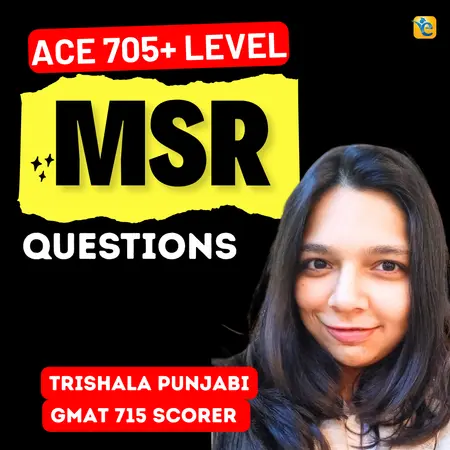Events & Promotions
|
|

GMAT Club Daily Prep
Thank you for using the timer - this advanced tool can estimate your performance and suggest more practice questions. We have subscribed you to Daily Prep Questions via email.
Customized
for You
Track
Your Progress
Practice
Pays
Not interested in getting valuable practice questions and articles delivered to your email? No problem, unsubscribe here.
- Nov 19
12:30 PM EST
-01:30 PM EST
Learn how Keshav, a Chartered Accountant, scored an impressive 705 on GMAT in just 30 days with GMATWhiz's expert guidance. In this video, he shares preparation tips and strategies that worked for him, including the mock, time management, and more - Nov 20
01:30 PM EST
-02:30 PM IST
Learn how Kamakshi achieved a GMAT 675 with an impressive 96th %ile in Data Insights. Discover the unique methods and exam strategies that helped her excel in DI along with other sections for a balanced and high score. - Nov 22
11:00 AM IST
-01:00 PM IST
Do RC/MSR passages scare you? e-GMAT is conducting a masterclass to help you learn – Learn effective reading strategies Tackle difficult RC & MSR with confidence Excel in timed test environment - Nov 23
11:00 AM IST
-01:00 PM IST
Attend this free GMAT Algebra Webinar and learn how to master the most challenging Inequalities and Absolute Value problems with ease. - Nov 24
07:00 PM PST
-08:00 PM PST
Full-length FE mock with insightful analytics, weakness diagnosis, and video explanations! - Nov 25
10:00 AM EST
-11:00 AM EST
Prefer video-based learning? The Target Test Prep OnDemand course is a one-of-a-kind video masterclass featuring 400 hours of lecture-style teaching by Scott Woodbury-Stewart, founder of Target Test Prep and one of the most accomplished GMAT instructors.
A
Be sure to select an answer first to save it in the Error Log before revealing the correct answer (OA)!
Difficulty:
 35%
(medium)
35%
(medium)
Question Stats:
70% (01:30) correct 30%
(01:37)
wrong
30%
(01:37)
wrong  based on 1748
sessions
based on 1748
sessions
History
Date
Time
Result
Not Attempted Yet
What is the remainder when the positive integer n is divided by the positive integer k, where k > 1 ?
(1) n = (k + 1)^3
(2) k = 5
(1) n = (k + 1)^3
(2) k = 5
Kudos
Bookmarks
What is the remainder when the positive integer n is divided by the positive integer k, where k>1
(1) \(n=(k+1)^3= k^3 + 3k^2 + 3k + 1=k(k^2+3k+3)+1\) --> first term, \(k(k^2+3k+3)\), is obviously divisible by \(k\) and 1 divide by \(k\) yields the remainder of 1 (as \(k>1\)). Sufficient.
(2) \(k=5\). Know nothing about \(n\), hence insufficient.
Answer: A.
(1) \(n=(k+1)^3= k^3 + 3k^2 + 3k + 1=k(k^2+3k+3)+1\) --> first term, \(k(k^2+3k+3)\), is obviously divisible by \(k\) and 1 divide by \(k\) yields the remainder of 1 (as \(k>1\)). Sufficient.
(2) \(k=5\). Know nothing about \(n\), hence insufficient.
Answer: A.
Kudos
Bookmarks
bunuel's solution is certainly the quickest way to solve. (Of course, it would be (k+1)^3 = k^3 + 3k^2 + 3k + 1, and since each of the "k" terms is divisible by k, the remainder is 1).
But if this deduction/concept didn't jump out at you, you could also solve fairly quickly by picking numbers. If we pick different integer values for k and always end up with the same remainder for n/k, then we can trust that (1) is sufficient. On the other hand, if ever we get different remainder values, we know at once (1) is insufficient:
(1): let k=2. Then, n = (2+1)^3 = 27. 27/2 leaves a remainder of 1.
----let k=3. Then, n = (3+1)^3 = 64. 63 is clearly divisible by 3. Thus, 64/3 leaves a remainder of 1 again.
----let k=4. Then, n = (4+1)^3 = 125. 124 is clearly divisible by 4. Thus, 125/4 leaves a remainder of 1 again.
We've convinced ourselves that (1) is sufficient!
But if this deduction/concept didn't jump out at you, you could also solve fairly quickly by picking numbers. If we pick different integer values for k and always end up with the same remainder for n/k, then we can trust that (1) is sufficient. On the other hand, if ever we get different remainder values, we know at once (1) is insufficient:
(1): let k=2. Then, n = (2+1)^3 = 27. 27/2 leaves a remainder of 1.
----let k=3. Then, n = (3+1)^3 = 64. 63 is clearly divisible by 3. Thus, 64/3 leaves a remainder of 1 again.
----let k=4. Then, n = (4+1)^3 = 125. 124 is clearly divisible by 4. Thus, 125/4 leaves a remainder of 1 again.
We've convinced ourselves that (1) is sufficient!














